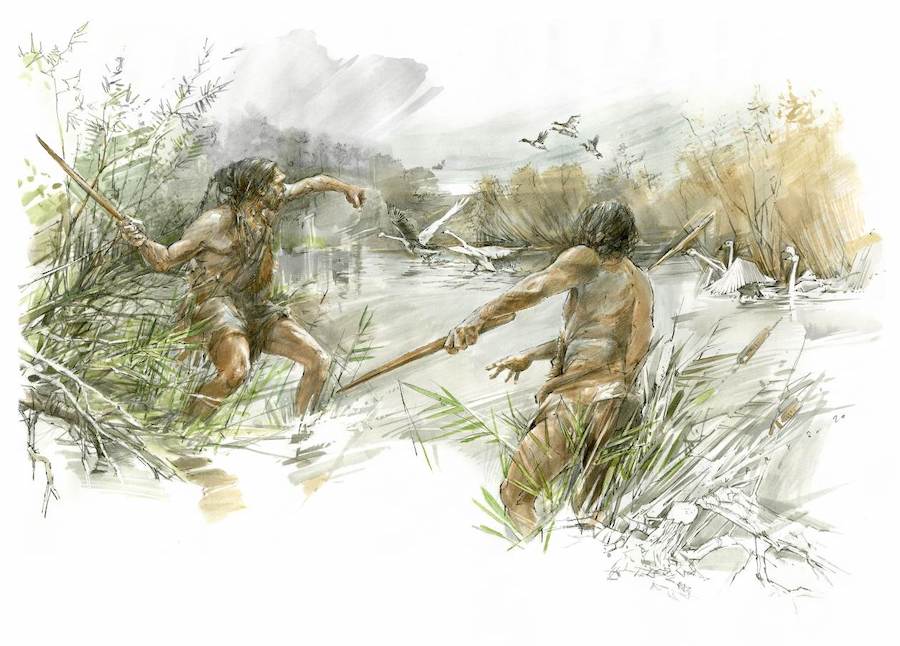News
20.04.2020
300,000-year-old throwing stick documents the evolution of hunting
Homo heidelbergensis used wooden weapons to hunt waterbirds and horses
Ice Age hunters in northern Europe were highly skilled and used a wide range of effective weapons. A wooden throwing stick found by the team of the University of Tübingen and the Senckenberg Center for Human Evolution and Paleoenvironment in Schöningen, Lower Saxony, Germany, highlights the complexity of early hunting. The discovery is presented in a new paper in Nature Ecology & Evolution.
Research at Schöningen demonstrates that already 300,000 years ago Homo heidelbergen-sis used a combination of throwing sticks, spears and thrusting lances. Prof. Nicholas Conard and Dr. Jordi Serangeli, who lead the research team, attribute the exceptional dis-covery to the outstanding preservation of wooden artifacts in the water saturated lakeside sediments in Schöningen.
The throwing stick was recovered in layer 13 II-4, which in the 1990s yielded examples of throwing spears, a thrusting lance and additional wooden tools of unknown function. Like almost all of these finds, the new artifact was carefully carved from spruce wood. The throwing stick is 64.5 cm long, 2.9 cm in diameter and weighs 264 grams. The cross-section is asymmetrical with a round and a flatter side.
Use-wear analysis conducted by Veerle Rots from the University of Liège shows how the maker of the throwing stick used stone tools to cut the branches flush and then to smooth the surface of the artifact. The artifact preserves impact fractures and damage consistent with that found on ethnographic and experimental examples of throwing sticks.
When in flight, throwing sticks, also referred to as „rabbit sticks” and “killing sticks” rotate around their center of gravity, and do not return to the thrower, as is the case with boomerangs. Instead the rotation helps to maintain a straight, accurate trajectory while increasing the likelihood of striking prey animals. Jordi Serangeli explains: “They are effective weapons at diverse distances and can be used to kill or wound birds or rabbits or to drive larger game, such as the horses that were killed and butchered in large numbers in the Schöningen lakeshore.” Remains of swans and ducks are well-documented in the find horizon.
Experiments show that throwing sticks of this size reach maximum speeds of 30 meters per second. Dr. Gerlinda Bigga, who studies the structure of the wood used for tools, remarked that “Ethnographic studies from North America, Africa and Australia show that the range of such weapons varies from 5 to over 100 meters.”
“The chances of finding Paleolithic artifacts made of wood are normally zero”, says Nicholas Conard. “Schöningen, with its exceptional preservation, has yielded by far the largest and most important record of wooden tools and hunting equipment from the Paleolithic.”
The excavations at Schöningen are funded by the Ministry of Science and Culture of the State of Niedersachsen and are conducted in cooperation with the State Heritage Office of Lower Saxony.
Publication:
Nicholas J. Conard, Jordi Serangeli, Gerlinde Bigga and Veerle Rots: “A 300,000-year-old throwing stick from Schöningen, northern Germany, documents the evolution of human hunting.” Nature Ecology & Evolution, DOI: 10.1038/s41559-020-1139-0
Videos on the website of Research Centre Schöningen: https://www.senckenberg.de/de/institute/shep/forschungsstation-schoeningen/
Contact:
Prof. Nicholas J. Conard, PhD
University of Tübingen
Senckenberg Center for Human Evolution and Paleoenvironment
nicholas.conardspam prevention@uni-tuebingen.de
Dr. Jordi Serangeli
University of Tübingen
Senckenberg Center for Human Evolution and Paleoenvironment – Research Centre Schöningen
jordi.serangelispam prevention@uni-tuebingen.de
Contact for press:
Eberhard Karls Universität Tübingen
Public Relations Department
Dr. Karl Guido Rijkhoek
Director
Antje Karbe
Press Officer
Phone +49 7071 29-76789
Fax +49 7071 29-5566
antje.karbespam prevention@uni-tuebingen.de
www.uni-tuebingen.de/en/university/news-and-publications
Senckenberg Gesellschaft für Naturforschung
Communications
Dr. Sören Dürr
Head of Communications
Judith Jördens
Telefon +49 69 7542 1434
judith.joerdensspam prevention@senckenberg.de
pressestellespam prevention@senckenberg.de
www.senckenberg.de/presse

